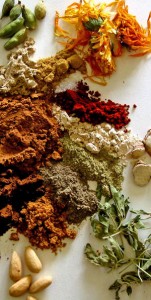Over de Tibetaanse kruidenleer
Uit Tibet, het land van de Himalaya, het dak van de wereld, komt een van de oudste (en nog steeds uitgeoefende) kruidenleer. Een traditie van wel meer dan vijfentwintighonderd jaar oud, van een volk dat eeuwenlang letterlijk op eenzame hoogte heeft geleefd.
De oudste teksten over de Tibetaanse gezondheidsleer dateren van de 7e eeuw na Christus. Via Rusland is deze traditie compleet met kruidenreceptuur eind 19e, begin 20e eeuw naar het westen gekomen. Via deze weg is de Tibetaanse kruidenleer behouden gebleven.
Holistisch
De Tibetaanse gezondheidsleer behelst een holistische, oftewel totale benadering van de mens. Kenmerk is dat de leer zich primair richt op de oorzaak van kwalen. In oude geschriften staat de volgende prachtige metafoor: als de oorzaak niet wordt bestreden, is het alsof men van een giftige boom alleen bladeren en takken heeft afgesneden zonder ook de wortels eruit te trekken. Hij zal zeker verder groeien.
Psychosomatisch
Als het gaat om die oorzaken dan neemt de Tibetaanse gezondheidsleer zeker ook de menselijke geest mee, als bron van gezondheid en het behouden ervan. Volgens deze psychosomatische kijk spelen een verkeerde voedingswijze in combinatie met stress en negatief denken een belangrijke rol bij lichamelijke verschijnselen. Onwetendheid, begeerte, haat, afkeer, gehechtheid en kortzichtigheid vormen in de Tibetaanse opvatting geestelijke vergiften die het lichaam uit zijn evenwicht brengen.
Vijf elementen, drie energieën
In de Tibetaanse gezondheidsleer gaat men ervan uit dat het menselijk lichaam bestaat uit vijf elementen: aarde, water, vuur, wind (lucht) en ruimte. Elk element oefent een bepaalde invloed uit op de levensfuncties van het lichaam. Verder wordt het lichaam beheerst door de drie energieën wind (loeng), gal (tripa) en slijm (pégèn) uit de Indiase ayurveda. Gezondheid is een kwestie van evenwicht tussen deze drie energiesystemen. Verstoringen in deze balans worden onderscheiden in warme of koude veranderingen, afhankelijk van de verstoorde energie en de elementen. Ook de functie van de organen kan worden omschreven als warm of koud, evenals verschillende soorten voedsel en kruiden. Een disbalans van de energiesystemen wind of slijm zijn koude verschijnselen; storingen van de gal en ‘onzuiver’ bloed zijn warme exponenten.
 Recepturen
Recepturen
De Tibetaanse kruidenproducten zijn gebaseerd op eeuwenoude kennis en ervaring van geneeskrachtige planten en mineralen. Ze bestaan uit combinaties van tientallen verschillende ingrediënten. Deze ingrediënten kunnen plantaardig zijn (de bast, wortel, bladeren of vruchten) of mineraal. De planten worden gedroogd en gemalen, maar zijn verder onbewerkt.
In de Tibetaanse gezondheidsleer gaat men ervan uit dat ieder enkelvoudig stof ook schadelijk kan zijn. Een plant die goed is voor een bepaald orgaan, werkt tegelijk bijna altijd negatief op een ander orgaan. Daarom is een deel van een Tibetaanse kruidenpreparaat bedoeld om het immuunsysteem te stimuleren, terwijl een ander deel zich richt op het neutraliseren van eventuele ongewenste reacties.
Tibetaanse kruidencombinaties leveren over het algemeen zacht helende impulsen. Daarom moeten ze langere tijd worden ingenomen voordat het resultaat merkbaar is.
Betrouwbaarheid
Is de Tibetaanse gezondheidsleer betrouwbaar? In bepaalde wetenschappelijke kringen heerst de opvatting dat eeuwenoude traditionele gezondheidsinzichten hun bestaansrecht hebben bewezen door hun overleving. Immers, het is zeer onwaarschijnlijk dat generatie na generatie zich door kwakzalverij zal laten bedriegen.  Uiteraard blijft wetenschappelijk onderzoek uiterst nuttig. Sinds de jaren ’70 van de vorige eeuw vinden aan westerse universiteiten in Zwitserland, Oostenrijk, Polen, Denemarken onderzoeken plaats naar de werking van de Tibetaanse gezondheidsleer en bevestigen hun bestaansrecht.
Uiteraard blijft wetenschappelijk onderzoek uiterst nuttig. Sinds de jaren ’70 van de vorige eeuw vinden aan westerse universiteiten in Zwitserland, Oostenrijk, Polen, Denemarken onderzoeken plaats naar de werking van de Tibetaanse gezondheidsleer en bevestigen hun bestaansrecht.
